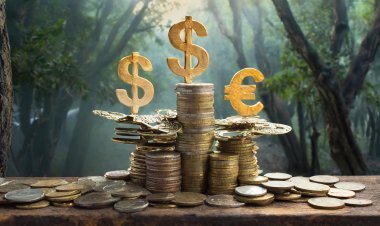The Ultimate 60-Minute Guide to Becoming a Forex Millionaire
Become a Forex Millionaire in Just 1 Hour? This no-nonsense guide unlocks the secrets to mastering the market, building wealth, and achieving financial freedom - in just 60 minutes! Start your millionaire journey now!

Introduction
In this section, we will review the year that has passed and set goals for the coming year. We want to invite you, the reader, to be part of our journey and promise to make you a Forex millionaire in 60 minutes. We understand that our readers have different skill levels, so we will address that as well.
As we reflect on the past year, we can't help but acknowledge the blessings we have received. We have travelled to more than 20 countries, visited multiple continents, acquired luxury cars and properties, and experienced many other successes. Looking ahead to the next year, our goal is simple: to make 10,000 people profitable in forex trading. We want you to be part of that journey and that goal.
Today, we are going to make you a Forex millionaire in 60 minutes. We will guide you step-by-step using practical strategies that have worked for us over the past 8 years of trading forex. Whether you are a beginner or an advanced trader, this video is for you. We will show you what is currently working in the forex market and how you can leverage it to achieve your financial goals.
Now, let's address the different skill levels of our readers. If this is your first time hearing about forex trading, don't worry. This video is designed to be beginner-friendly and will provide you with all the information you need to get started. If you have been struggling to make money in forex trading for years, this video is also for you. We will share strategies and techniques that can help you turn things around. Even if you are an advanced trader, we believe there is always something new to learn. We will provide insights into what is working in the current market and how you can adapt your trading strategies accordingly.
What is forex trading?
Forex trading, also known as foreign exchange trading, is the act of buying and selling currencies in the global market. It is a decentralised market where currencies are traded 24 hours a day, five days a week. In forex trading, traders aim to profit from the fluctuations in exchange rates between different currencies.
The Forex market is the largest financial market in the world, with an average daily trading volume of $6.6 trillion. It operates on a global scale, with participants including banks, financial institutions, hedge funds, and individual traders like you.
Currency pairs play a crucial role in forex trading. A currency pair is the quotation of the relative value between two currencies. For example, the EUR/USD pair represents the exchange rate between the Euro and the US Dollar. Currency pairs are always quoted in pairs, with one currency being the base currency and the other being the quote currency.
Liquidity is of utmost importance in forex trading. Liquidity refers to the ease with which an asset can be bought or sold without causing a significant change in its price. The Forex market is highly liquid, which means that there is a large volume of trades happening at any given time. This high liquidity ensures that traders can enter and exit positions quickly without worrying about market manipulation or price fluctuations.
A Live Example of a Forex Transaction
A real-life Forex transaction involves the buying and selling of currencies in the global market. Currency exchange rates play a crucial role in these transactions as they determine the relative value between two currencies. Let's take a look at an example of exchanging currency at an airport to understand how a forex transaction works.
Imagine you are planning a vacation to the United States and need to exchange 100,000 South African Rand (ZAR) for US dollars (USD) at the airport. You check the exchange rate on the Forex Bureau board and see that 1 USD is equivalent to 18 ZAR. So, to exchange your 100,000 ZAR, you would receive 5,555.55 USD.
However, after 30 minutes, you receive news that all flights have been cancelled due to unforeseen circumstances. Now, you need to convert your USD back to ZAR. Unfortunately, the exchange rate has shifted, and 1 USD is now equivalent to 20 ZAR. So, when you convert your 5,555.55 USD back to ZAR, you will receive 111,111.11 ZAR.
In this scenario, you started with 100,000 ZAR and ended up with 111,111.11 ZAR, resulting in a profit of 11,111.11 ZAR. This demonstrates how the fluctuation in exchange rates can lead to potential gains or losses in forex transactions.
Calculating profit or loss from a currency exchange is relatively simple. By subtracting the initial amount exchanged from the final amount received, you can determine the profit or loss. In this case, the profit was 11,111.11 ZAR.
Understanding and keeping track of exchange rates is crucial in forex trading, as it allows traders to make informed decisions. By monitoring exchange rates and predicting their movements, traders can make profitable transactions and achieve their financial goals.
Demo, Live, and Prop Firm Accounts
A demo account is a type of trading account that allows you to practice trading in the Forex market using virtual or fake money. Its purpose is to provide a risk-free environment for beginners to learn how to trade and for experienced traders to test new strategies.
Practicing with fake money is important because it allows you to gain experience and confidence without risking your own capital. It gives you the opportunity to understand how the market works, test different trading strategies, and learn from your mistakes without any financial consequences.
Once you have practiced enough with a demo account and feel comfortable with your trading skills, you can transition to a live account. A live account is a real trading account where you deposit your own money and trade with real funds. It is essential to be aware that trading with real money can evoke emotions and affect decision-making. Therefore, it is crucial to start with a small amount of capital that you can afford to lose.
In addition to live accounts, there are also prop firm accounts available. A prop firm, short for proprietary firm, is a company that provides traders with capital to trade on behalf of the firm. In other words, they give traders the opportunity to trade with larger amounts of money than they would have on their own. Traders are usually paid a portion of the profits they generate.
Using a prop firm account can be advantageous because it allows traders to access more capital and potentially make higher profits. However, it is important to note that prop firms have their own rules, criteria, and evaluation processes that traders must adhere to. It is essential to thoroughly research and understand the terms and conditions of a prop firm before engaging in any trading activities with them.
Types of Trading Strategies
When it comes to Forex trading, there are various strategies that traders can employ to maximise their profits. Each strategy has its own unique characteristics and is suitable for different trading styles. Here are some commonly used trading strategies:
Scalping Strategy
The scalping strategy is a short-term trading strategy that aims to make small profits by quickly opening and closing trades. Scalpers typically hold their positions for a few seconds to a few minutes. This strategy relies on identifying short-term price fluctuations and taking advantage of them. Scalpers often use high leverage and trade in large volumes to maximise their profits.
Day Trading Strategy
Day trading involves opening and closing trades within the same trading day. Day traders aim to take advantage of short-term price movements and capitalise on intraday volatility. They closely monitor the market and make quick trading decisions based on technical analysis and market indicators. Day trading requires discipline and the ability to make fast decisions under pressure.
Swing Trading Strategy
Swing trading is a medium-term trading strategy that aims to capture larger price movements over a few days to a few weeks. Swing traders identify market trends and enter trades at key support and resistance levels. They aim to hold their positions for a longer period of time to ride the momentum of the market. Swing trading requires patience and the ability to analyse both technical and fundamental factors.
Choosing the Right Strategy for an Individual Skill Level
Choosing the right trading strategy is crucial for success in the forex market. Traders should consider their skill level, risk tolerance, and trading goals when selecting a strategy. Beginners may find it easier to start with a longer-term strategy like swing trading, as it allows more time for analysis and decision-making. As traders gain experience and confidence, they can explore shorter-term strategies like scalping and day trading.
It's important for traders to remember that no strategy is foolproof and that losses are a part of trading. It's also important to continually refine and adapt trading strategies as market conditions change. Traders should focus on developing a solid understanding of the chosen strategy and practice it in a demo account before risking real capital. With time and experience, traders can find a strategy that aligns with their skills and helps them achieve their financial goals.
Tips for Developing a Profitable Strategy
Developing a profitable strategy is essential for success in forex trading. Here are some tips to help you create a strategy that can generate consistent profits:
Avoiding strategy hopping
One common mistake many traders make is constantly switching between different trading strategies. This can be detrimental to your success, as it prevents you from fully understanding and implementing a single strategy. Instead of constantly changing strategies, focus on mastering one strategy and refining it over time.
The importance of a trading plan
A trading plan is a crucial component of a profitable strategy. It outlines your goals, risk tolerance, entry and exit points, and other important considerations. Having a well-defined trading plan helps you stay disciplined and make informed decisions based on predetermined criteria.
Backtesting and demo trading
Before implementing a strategy with real money, it's important to backtest and demo-trade it. Backtesting involves analysing historical data to see how the strategy would have performed in the past. Demo trading allows you to practice the strategy in a simulated trading environment without risking real money. These steps help you gauge the effectiveness of your strategy and make necessary adjustments.
An example of a support and resistance strategy
One popular strategy among forex traders is the support and resistance strategy. This strategy involves identifying levels of support (price level where buying interest is strong) and resistance (price level where selling pressure is strong). Traders look to buy near support levels and sell near resistance levels, taking advantage of price reversals. Combining support and resistance with other technical indicators can increase the accuracy of trades.
Overall, developing a profitable strategy requires dedication, practice, and continuous improvement. Avoid strategy hopping, create a trading plan, backtest and demo trade your strategy, and consider incorporating support and resistance levels into your trading approach. With time and experience, you can develop a strategy that aligns with your goals and helps you achieve profitability in forex trading.
Transitioning to Profitable Trading
Once you have practiced trading in a demo account and feel comfortable with your skills, you can transition to a live account to start trading with real money. Here are some key points to consider during this transition:
Using a profitable strategy in a live account: The strategy that you have been practicing and refining in your demo account can now be applied in a live trading environment. Make sure to track your results and adjust your strategy as needed.
Importance of risk management: As you transition to a live account, it is crucial to implement proper risk management techniques. This includes setting stop-loss orders, determining appropriate position sizes, and not risking more than a certain percentage of your account on any single trade.
Using prop firm accounts to raise capital: Proprietary trading firms, or prop firms, provide traders with capital to trade on behalf of the firm. This can be a way to access more capital and potentially increase your profits. However, it is important to thoroughly research and understand the terms and conditions of a prop firm before getting involved.
Reinvesting profits into a private account: As you start making profits in your trading, consider reinvesting a portion of those profits back into your trading account. This can help grow your capital and potentially increase your trading opportunities.
Remember, transitioning to profitable trading takes time and practice. It is important to continuously refine your strategies, manage your risk effectively, and stay disciplined in your trading approach. With dedication and experience, you can become a profitable trader in the forex market.
Trading Psychology and Conclusion
Addressing the importance of mindset in trading:
-
Having the right mindset is crucial in trading. A positive and disciplined mindset can help you make better trading decisions and overcome challenges.
-
Developing a mindset of patience, perseverance, and adaptability is key, as trading can be unpredictable and requires the ability to adapt to changing market conditions.
-
Believing in your trading strategy and having confidence in your abilities is important for success in trading.
Overcoming emotional trading:
-
Emotions can often cloud judgement and lead to impulsive trading decisions. It's important to manage emotions such as fear, greed, and impatience.
-
Creating and following a trading plan can help you avoid emotional trading. Stick to your strategy and avoid making impulsive decisions based on emotions.
-
Practicing self-discipline and emotional control is crucial. Take breaks when needed and maintain a balanced mindset.
Summary of Key Points:
-
Forex trading involves buying and selling currencies in the global market. The Forex market is the largest financial market in the world, with an average daily trading volume of $6.6 trillion.
-
Currency pairs are traded in the Forex market, and liquidity is important for quick and efficient trading.
-
Having a demo account allows traders to practice trading strategies and gain experience without risking real money.
-
Transitioning to a live account involves using real money to trade. Emotions play a larger role in live trading, and it's important to manage emotions and stick to your trading plan.
-
Proprietary firm accounts provide traders with capital to trade on behalf of the firm, allowing them to access more capital and potentially increase profits.
-
Developing a profitable trading strategy requires dedication, practice, and continuous improvement. Backtesting and demo trading can help refine and improve strategies.
Encouragement for readers to start their journey:
Trading forex can be a challenging but rewarding journey. With the right mindset, knowledge, and practice, you can become a successful trader.
Start by opening a demo account and practicing your strategies. As you gain experience and confidence, transition to a live account and continue to refine your strategies.
Remember to manage your emotions, stick to your trading plan, and continually educate yourself about the Forex market.
With dedication and perseverance, you can achieve your financial goals as a Forex trader.
FAQ
Answer common questions about forex trading.
Forex trading can seem overwhelming, especially for beginners. Here are some frequently asked questions to help you better understand the world of forex trading:
What is forex trading?
Forex trading, also known as foreign exchange trading, is the act of buying and selling currencies in the global market. Traders aim to profit from the fluctuations in exchange rates between different currencies.
How does the forex market work?
The Forex Market is a decentralised market where currencies are traded 24 hours a day, five days a week. It is the largest financial market in the world, with an average daily trading volume of $6.6 trillion. Participants in the market include banks, financial institutions, hedge funds, and individual traders.
What are currency pairs?
Currency pairs play a crucial role in forex trading. A currency pair is the quotation of the relative value between two currencies. For example, the EUR/USD pair represents the exchange rate between the Euro and the US Dollar. Currency pairs are always quoted in pairs, with one currency being the base currency and the other being the quote currency.
What is a demo account?
A demo account is a type of trading account that allows you to practice trading in the Forex market using virtual or fake money. It provides a risk-free environment for beginners to learn how to trade and for experienced traders to test new strategies.
What is a live account?
A live account is a real trading account where you deposit your own money and trade with real funds. It is essential to be aware that trading with real money can evoke emotions and affect decision-making. It is crucial to start with a small amount of capital that you can afford to lose.
What is a prop firm account?
A prop firm, short for proprietary firm, is a company that provides traders with capital to trade on behalf of the firm. Traders are usually paid a portion of the profits they generate. Using a prop firm account can be advantageous because it allows traders to access more capital and potentially make higher profits.
What are some tips for success in forex trading?
1. Develop a profitable trading strategy and stick to it.
2. Practice risk management and never risk more than you can afford to lose.
3. Continuously educate yourself and stay up-to-date with market trends.
4. Stay disciplined and avoid emotional trading.
5. Use demo accounts and backtesting to refine your strategies before trading with real money.
6. Set realistic goals and have patience. Forex trading is not a get-rich-quick scheme.
7. Always be willing to learn and adapt to market changes.
Remember, success in forex trading takes time, practice, and continuous learning. It is important to have a solid understanding of the market and use proven strategies to achieve profitability.



 WaveTrendZ
WaveTrendZ 
























